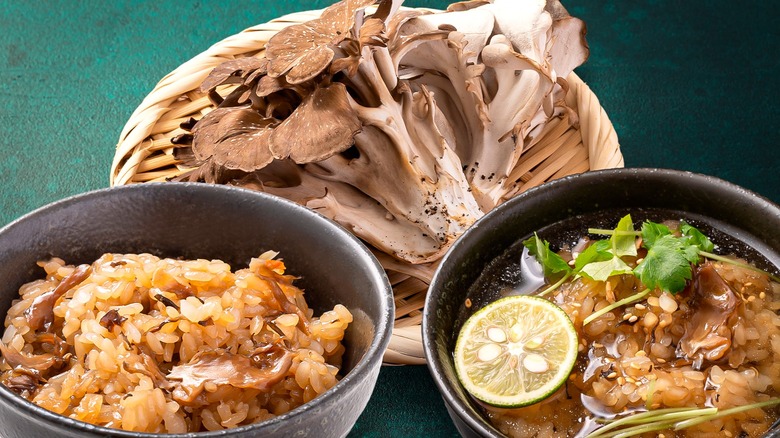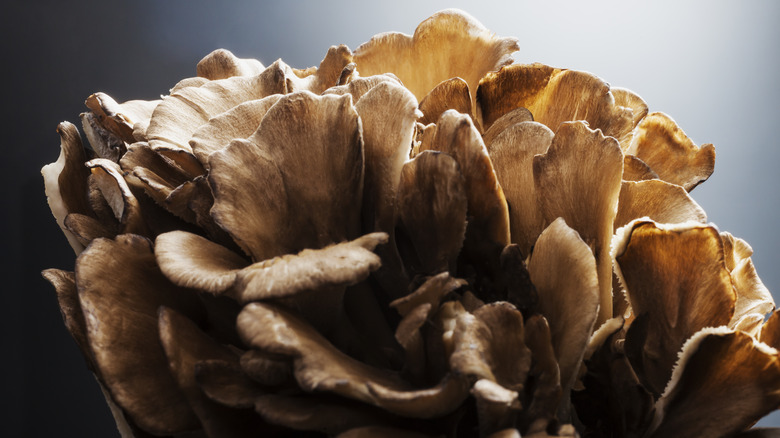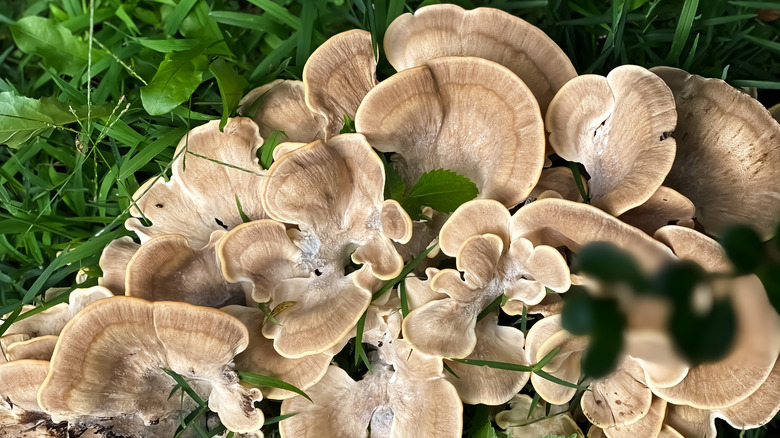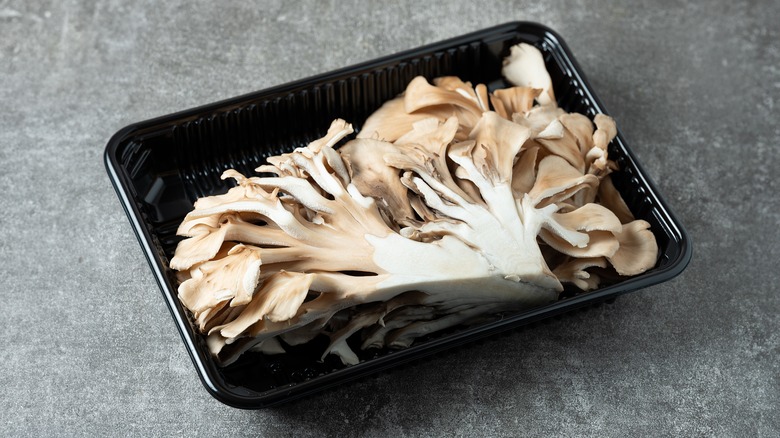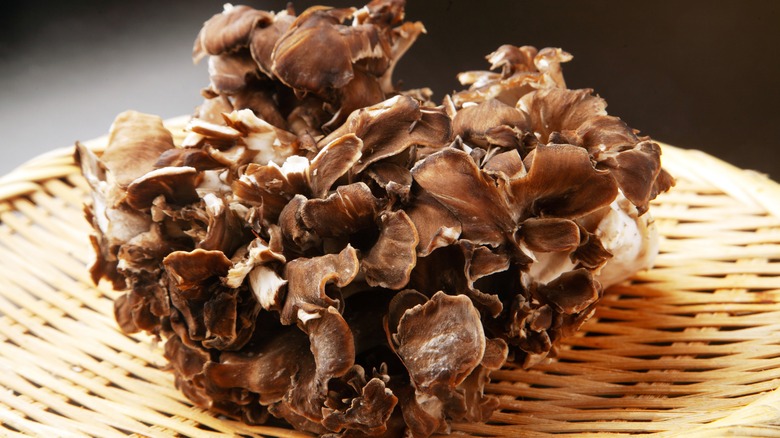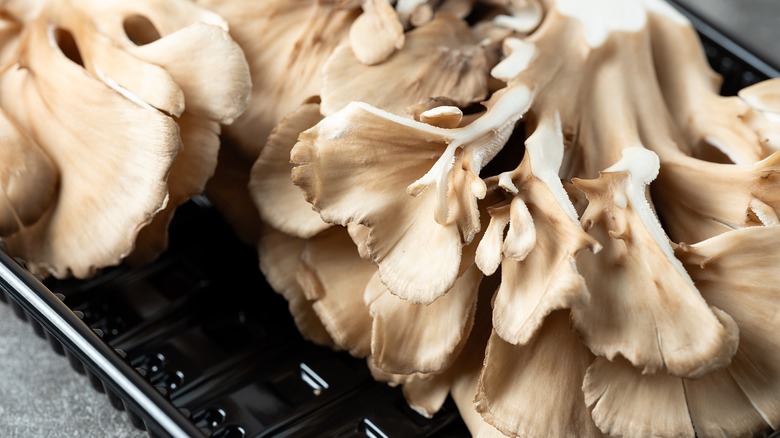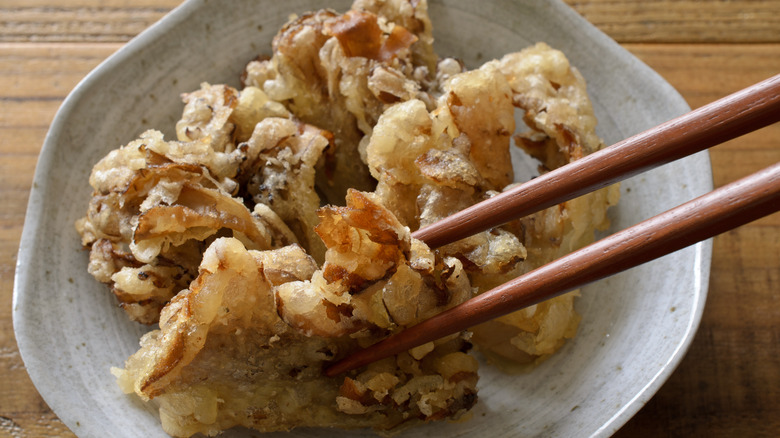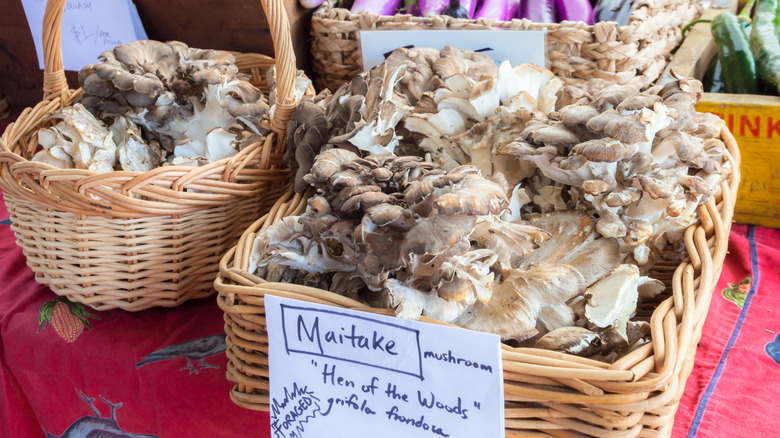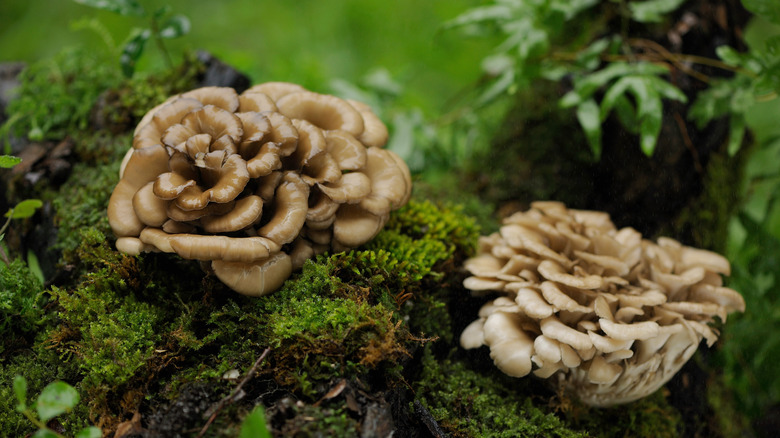What To Know When Cooking With Maitake Mushrooms
There's more to the world of mushrooms than the white button variety commonly found in your grocery store's produce section. Although there are some 14,000 types of mushrooms, only 2,200 are classified as edible. Different types of mushrooms have distinct characteristics that will impart unique flavors and textures to varied recipes, which range from cream of mushroom soup to a cheesy mushroom lasagna. If you're looking to expand your mushroom repertoire beyond the common creminis, shiitakes, and portobellos, as a professionally trained chef, I recommend adding maitake mushrooms into the mix.
Maitake is an edible mushroom that can grow up to 100 pounds, and it offers a unique combination of umami-filled flavor, versatility, and nutrition in the kitchen. The rich, savory flavor and firm texture of maitake adds a depth of flavor to dishes like stir-fries and risottos. In Japanese, maitake translates to "dancing mushroom," and many believe this is because foragers danced with happiness when they would stumble upon this oversized fungus. Researchers have referred to maitake as the king of mushrooms, due to their health-boosting benefits. Mushroom lovers everywhere should incorporate this meaty marvel into their recipes. Here's what you need to know.
What are maitake mushrooms?
Maitakes are edible mushrooms that grow in clusters at the base of hardwood trees, particularly oak trees. They're also known as "hen of the woods" due to their layered appearance that resembles a hen's tail feathers. Maitake mushrooms grow in soft clusters with caps that are brownish-gray on top and white underneath.
They're part of the polypore family of mushrooms that are characterized by their large bodies with pores or tubes underneath. As organisms, maitake mushrooms assist in the decomposition of wood, which means that any tree they're found growing on is in danger of dying or already decaying. If you find a hen of the woods in the wild, make sure to only forage it if the mushroom is firm and smooth, not sticky and with no off coloring.
In the kitchen, maitake mushrooms are extremely versatile. You can use them in place of other mushrooms in everything from a mushroom stew to a mixed mushroom grilled cheese. Their sturdy composition allows them to hold up well to cooking techniques like roasting, sautéing, and braising.
Where are maitake mushrooms grown?
A temperate climate is required for maitake mushrooms to grow naturally in wooded areas. They are native to Europe, North America, and Asia, but they can be cultivated as well. You can even grow maitakes indoors with some special equipment.
Maitakes are among the common types of mushrooms produced in the United States, along with white button, cremini, portobello, enoki, and oyster varieties. In the wild, these mushrooms are primarily found east of the Rocky Mountains.
In Japan, maitakes are big business — one company claims to cultivate almost 38 tons of maitakes every day. Baldor Specialty Foods, a leading maitake mushroom producer in the United States, cultivates their hen of the woods in a Rhode Island facility with a steadily maintained low temperature and a humidity level kept above 95%. South Mill Champs and Phillips Mushroom Farms are two other prominent U.S.-based maitake producers, with both located in Kennett Square, Pennsylvania — a community known as the mushroom capital of the world.
What do maitake mushrooms taste like?
If you're aware of the five basic tastes, you might already be familiar with the term umami. In addition to sweet, sour, salty, and bitter, it's one of the primary sensations that our taste buds recognize. Some people have a difficult time discerning the difference between salty and umami tastes, but they are distinct from each other. Umami is a rich, savory flavor often expressed as meaty.
Described as earthy, rich, and woody, maitake mushrooms have a particularly deep flavor that makes it an excellent meat substitute. They have a peppery note and a luscious, sturdy texture.
While all mushrooms contain umami flavor, the darker the mushrooms are in color, the more umami they contain. Maitakes in particular are known for their robust, umami-filled taste. This is one of the reasons maitakes are used to make umami-rich seasonings, with the mushrooms ground to a powder and sprinkled onto other foods for added flavor.
How to store maitake mushrooms
Proper storage of maitake mushrooms will preserve their freshness and extend their shelf life. They require a cool environment for the best results. Place fresh maitakes in a paper bag in the refrigerator, where they should last from about five days to one week. You can wrap them gently in a damp paper towel first to preserve their moisture. If you're preparing your mushroom dish sooner rather than later, you can store them in a paper bag or another breathable container on your kitchen counter. Maitakes need some air circulation to stay fresh, so avoid storing them in plastic bags, which can trap excess moisture and cause the mushrooms to spoil faster.
If you have an abundance of maitake mushrooms or want to save some for later, freezing is a long-term storage option. To freeze them, clean and dry the mushrooms first, and then place them in vacuum-sealed plastic bags to keep in your freezer.
How to clean maitake mushrooms
It's important to clean maitake mushrooms thoroughly before cooking or eating them. The process will vary based on whether you're working with wild or cultivated mushrooms. Wild maitakes will require more work to prepare them for use. Because they grow close to the ground on tree trunks, they are exposed to soil, insects, and other critters. The cluster formations of maitakes can very easily trap dirt and debris between their layers, and bits of wood from the trees they grow on can become embedded in their flesh. Cleaning them well is essential.
To clean maitakes, use a knife to trim away any soiled, damaged, or discolored pieces. Try to preserve as much of the mushroom flesh as possible. Tear or cut the mushrooms into smaller pieces, checking each segment for hidden dirt or bugs. If any dirt remains, you can lightly spray the mushrooms with a little cold water to cleanse them, but try not to soak the pieces. If your mushrooms become waterlogged, both their texture and taste will be altered. Mushrooms that are extremely dirty and require some water to fully clean them can be spun in a salad spinner to remove the excess moisture.
Cultivated or homegrown maitakes don't require as much work to clean. You can use a damp cloth or paper towel to gently wipe away any soil.
How to cook with maitake mushrooms
Cooking with maitake mushrooms is a delicious experience, and their rich flavor and hearty texture make them well-suited to a variety of recipes. They are ideal for dishes ranging from a quinoa-mushroom salad to a mushroom burger with pickled maitake aioli. The simplest way to enjoy maitake mushrooms is to clean them thoroughly and add them raw to your favorite salad, but they are also terrific when cooked.
One benefit of cooking with maitake mushrooms is that they don't require complicated preparation to make them tasty. Simply sauté them in olive oil, butter, or a mix of both, cooking them until the edges begin to brown and crisp. You can cook them as whole clusters or cut them into smaller pieces, depending on your preference. Roasting them is another easy way to prepare maitakes. All you need to do is toss the mushrooms in olive oil and your favorite seasonings, then place them on a sheet tray. Roast them at 400 F for 15 to 25 minutes.
Maitakes are commonly used to prepare vegetarian or vegan meals. Their hearty texture and big flavor, combined with their meaty qualities, makes these mushrooms an excellent substitute for meat.
Where to buy maitake mushrooms
You can purchase maitake mushrooms at a variety of locations, depending on the season and the region. Specialty grocery stores or local grocery co-ops are likely to carry a wide variety of mushrooms, including maitakes, particularly when they're in season from late summer through autumn.
If you're lucky enough to live in an area where maitakes are grown, you may find them offered by small producers at farmers markets and local grocery stores. You can also find maitakes at Asian grocery stores and markets, since they have long been cherished in Japan and China.
Your best bet for buying maitake mushrooms might be online. Several producers and online stores sell them in both their fresh and dried forms, and they can be delivered right to your door. High-end brands like D'Artagnan sell fresh maitakes, and dried maitakes are also available online. The latter product provides a convenient alternative that allows you to enjoy the flavor of maitakes without worries about freshness or shelf life.
Nutritional information about maitake mushrooms
In addition to their great flavor, maitake mushrooms are also rich in nutrients. They have long been used in traditional Japanese and Chinese medicine because of their perceived health benefits.
Maitakes are an excellent source of vitamin D, which provides anti-inflammatory properties, supports bone health, and boosts the immune system. These mushrooms also contain ample doses of niacin, potassium, and magnesium. Some reports support the theory that maitake mushrooms can help lower blood sugar levels for people with diabetes. Maitakes are also adaptable for a variety of diets, being low in sodium and calories. A cup of fresh maitakes contains only 22 calories and less than a gram of fat.
Powdered maitake extract has been found to lower cholesterol, and many researchers believe adding maitakes to your diet can help prevent and treat cancer. These mushrooms may also help lower blood pressure.
